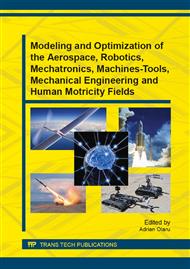p.549
p.555
p.561
p.567
p.575
p.580
p.586
p.593
p.601
Method for Manufacturing Custom-Shaped Prosthetic Parts from Titanium Alloys by Incremental Forming Using Industrial Robots
Abstract:
The last decade has shown an increasing interest in a new class of forming processes known as Incremental Sheet forming (ISF). A possible application for this new procedure, targeted by the authors of this paper, is the manufacturing of custom-shaped prosthetic parts for use in various areas of human medicine. Such prostheses can have a functional role, when they target the replacing of a functional component of the human body, or an esthetic role, when they target the solving of problems related to the appearance of the human body. In this paper the authors aim to determine the strain hardening curves for the titanium alloy Ti6Al4V at room temperature and at 800°C. The incremental forming process will be performed by means of an industrial robot.
Info:
Periodical:
Pages:
575-579
Citation:
Online since:
June 2014
Authors:
Keywords:
Price:
Сopyright:
© 2014 Trans Tech Publications Ltd. All Rights Reserved
Share:
Citation:


